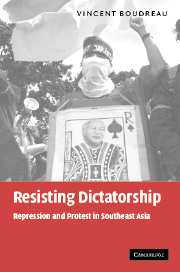Book contents
- Frontmatter
- Contents
- List of maps
- Acknowledgments
- List of abbreviations
- 1 Introduction
- 2 Protest, repression and transition in Southeast Asia
- 3 Authoritarian attack and dictatorial rise
- 4 Protest in socialist Burma
- 5 New Order repression and the Indonesian opposition
- 6 The Philippine new society and state repression
- 7 Repression and protest in comparative perspective
- 8 People power and insurgency in the Philippine transition
- 9 Protest and the underground in Burma
- 10 Indonesia's democracy protests
- 11 Democracy protest and state repression
- List of references
- Index
5 - New Order repression and the Indonesian opposition
Published online by Cambridge University Press: 15 December 2009
- Frontmatter
- Contents
- List of maps
- Acknowledgments
- List of abbreviations
- 1 Introduction
- 2 Protest, repression and transition in Southeast Asia
- 3 Authoritarian attack and dictatorial rise
- 4 Protest in socialist Burma
- 5 New Order repression and the Indonesian opposition
- 6 The Philippine new society and state repression
- 7 Repression and protest in comparative perspective
- 8 People power and insurgency in the Philippine transition
- 9 Protest and the underground in Burma
- 10 Indonesia's democracy protests
- 11 Democracy protest and state repression
- List of references
- Index
Summary
Despite the Indonesian New Order regime's inaugural mass murders, it has since been relatively lenient toward demonstrations of a certain kind particularly in comparison to socialist Burma. Student protests, localized land and labor disputes, NGO-led environmental demonstrations, provoke periodic (not inevitable) arrest, injury or murder. Participants in such action (at least into the 1980s and even acknowledging prominent state violence against labor activists in the 1990s) seldom experience the kinds of prison torment one associates with dictatorship, and commonly spent relatively short spans behind bars. Other forms of dissent and resistance, however, predictably called forth sharp state violence. Outer island separatist movements in East Timor, West Papua, and Aceh drew sustained, brutal repression, as did any movement that sought to develop strong organizational structures and capacities. Hence, for almost two decades, the New Order presented two contrasting faces, depending on the mode of resistance it confronted: one committed to bloody and unremitting repression, the other more willing to tolerate dissent that it probably still disliked, and also subjected to intense surveillance.
The New Order wove a repressive strategy from two legacies of its bloody rise. First, the anti-PKI struggle physically eliminated the only force that, in terms of organizational capacity, could rival ABRI for pre-eminence. Suharto then expanded corporatist structures that deepened his organizational monopoly and restricted the legal possibility of organizing dissent outside state agencies.
- Type
- Chapter
- Information
- Resisting DictatorshipRepression and Protest in Southeast Asia, pp. 103 - 133Publisher: Cambridge University PressPrint publication year: 2004



